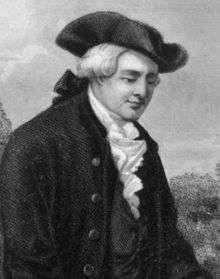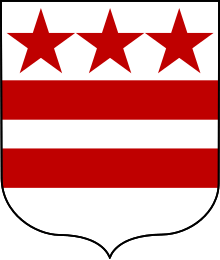Augustine Washington
Augustine Washington Sr. (November 12, 1694 – April 12, 1743) was the father of the first U.S. President, George Washington. He belonged to the Colony of Virginia's landed gentry and was a planter and slaveholder.
Augustine Washington Sr. | |
|---|---|
 Posthumous 1867 lithograph by John C. McRae after a painting by G. G. White | |
| Born | November 12, 1694 |
| Died | April 12, 1743 (aged 48) |
| Resting place | Popes Creek, Colony of Virginia, British America |
| Occupation | Planter|Slaver |
| Spouse(s) | Jane Butler
( m. 1715; died 1730) |
| Children | Butler Washington Lawrence Washington Augustine Washington Jr. Jane Washington George Washington Betty Washington Lewis Samuel Washington John Augustine Washington Charles Washington Mildred Washington |
| Parent(s) | Lawrence Washington Mildred Warner |
Family
Augustine Washington was born in Westmoreland County, Virginia, on November 12, 1694 to Capt. Lawrence Washington, a militia captain and a member of the Virginia House of Burgesses, and Mildred Warner.
His paternal grandparents were Lt. Col. John Washington (c. 1631–1677) and his first wife, Anne Pope.
Life
Augustine was four years old when his father died. He inherited about 1,000 acres (4.0 km2) on Bridges Creek in Westmoreland County; his sister Mildred inherited what was called the Little Hunting Creek property;[1] they both inherited slaves.
When Washington came of age (and into his inheritance) in 1715, he married Jane Butler, an orphan who had inherited about 640 acres (2.6 km2) from her father. The young couple settled on the Bridges Creek property. Washington was active in the Anglican Church and in local politics. He took the oath as justice of the peace for the county court in July 1716,[2] and served as county sheriff.
In 1718, Washington purchased land on Popes Creek, abridging his property on Bridges Creek. About 1726, he had a new house built there (later called Wakefield). In the same year, he purchased the Little Hunting Creek property from his sister Mildred. Washington and his first wife, Jane Butler, had four children, only two of whom (Lawrence and Augustine Jr.) lived to adulthood. In 1725, Augustine entered into an agreement with the Principio Company of England to start an iron works on Accokeek Creek in Stafford County. After Jane's death in November 1728[3] or 1729,[4] Washington married Mary Ball in 1731, and in 1735, the family moved to the Little Hunting Creek property, which was closer to the Accokeek Furnace.[1]
In 1738, Augustine Washington purchased the 150-acre Strother property across the Rappahannock River and moved the family there at the end of that same year.[1]
Legacy
After Washington's death in 1743 at the age of 48, his son George inherited the former Strother property and its slaves. As he was only 11 years old,[5] his mother Mary managed the property for him until he came of age. She lived on the property until 1772 when she was 64. George then moved her to a house in Fredericksburg.
Lawrence inherited the Little Hunting Creek property and renamed his property Mount Vernon, in honor of Admiral Edward Vernon, with whom he had served in the Royal Navy in 1741 during the Battle of Cartagena de Indias during the War of Jenkins' Ear.
Augustine Jr. inherited the Popes Creek property and slaves. At his death, Augustine Washington Sr. held a total of 64 slaves who were assigned among the various plantations.[6]
According to Augustine's will, if Lawrence died without children, the Little Hunting Creek property would be given to Augustine Jr. with the stipulation that he must then give Popes Creek to George. If Augustine Jr. did not want the Little Hunting Creek property, it would then be inherited by George. At Lawrence's death, Augustine Jr. did not want to give up Popes Creek, and Lawrence's only surviving child Sarah lived only until 1754; therefore, George Washington ultimately inherited the Little Hunting Creek property.
Lawrence Washington's widow Ann had a life interest in the Little Hunting Creek plantation. As she remarried and was not living at Mount Vernon, she leased the property to George beginning in 1754. Upon her death in 1761, George Washington inherited the plantation outright.
Children (by Jane Butler)
- Butler Washington (1716–1716)
- Lawrence Washington (1718–1752)
- Augustine Washington Jr. (1720–1762)
- Jane Washington (1722–1735)
Children (by Mary Ball)
- George Washington (1732–1799)
- Betty Washington Lewis (1733–1797)
- Samuel Washington (1734–1781)
- John Augustine Washington (1736–1787)
- Charles Washington (1738–1799)
- Mildred Washington (1739–1740)
See also
Notes
- ""Augustine Washington", The George Washington Foundation". Archived from the original on September 9, 2019. Retrieved November 2, 2015.
- Freeman 1948, p. 34
- Whipple, Wayne, ed. (1911). The story-life of Washington: a life-history in five hundred true stories. John C. Winston Company. p. 17. Retrieved February 20, 2018.
...died November 24, 1728
- Proceedings of the Massachusetts Historical Society. 1880. p. 241.
- "10 Facts About Washington & Slavery - 1. George Washington first became a slave owner at the early age of eleven". www.mountvernon.org. Mount Vernon Ladies' Association. Retrieved June 6, 2020.
- "Slavery at Popes Creek Plantation", George Washington Birthplace National Monument, National Park Service, accessed April 15, 2009
References
- Freeman, Douglas Southall (1948). George Washington: A Biography (Volume 1). New York: Charles Scribner's Sons.
External links
- "George Washington's Heritage", March 26, 2005, Fredricksburg.com.
- "Lawrence Washington History, 1659-1698", National Park Service
